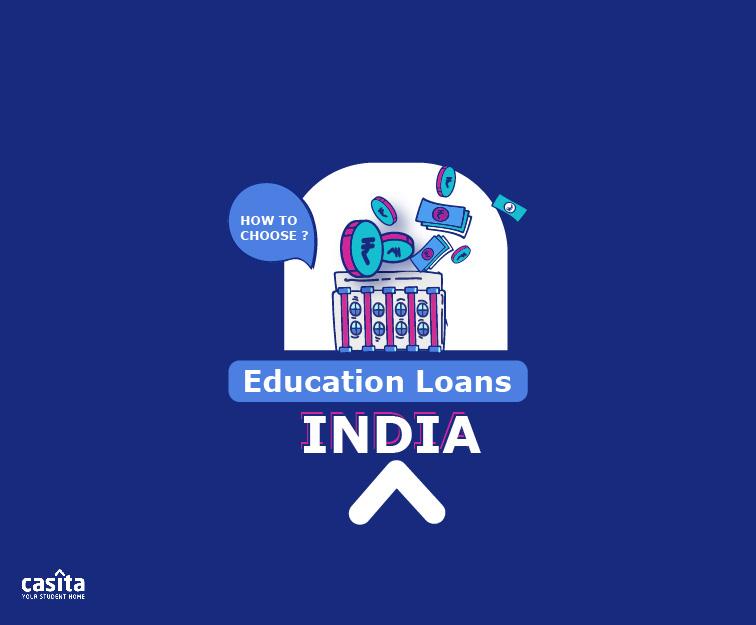How to Apply for a Student Loan in India
Student Finance
6 mins read
Share

Updated at: 25 November, 2025
Published at: 14 March, 2021
By Hadeel Hossam
How to Apply for a Student Loan in India
Student Finance
6 mins read

Updated at: 25 November, 2025
Published at: 14 March, 2021
By Hadeel Hossam
Share
A high-quality education has become a necessity to ensure promising career prospects. However, with education fees increasing each year, this necessity has become more challenging to achieve. Even when students maintain a perfect academic record, most scholarships still do not cover the entire cost of university education, whether locally or abroad. In India, it’s no different; students also struggle to avail themselves of the opportunity for higher education in the main educational institutions of their choice. That’s why it might be a good idea to apply for a student loan in India to achieve your ideal educational experience. Here’s all you need to know to apply for a student loan in India:
How Do Student Loans Work?
A student loan is an amount of money that is borrowed from the government or a private entity to facilitate finances for students applying to higher education in India or abroad. Students can apply for a loan whether they are pursuing a graduate or postgraduate degree, a full-time course, a part-time course, or a vocational course. These loans cover tuition fees, student accommodation fees, books, examination fees, travel expenses, and other costs. Government loans have the perk of lower interest rates and can be returned either after a specified period of time or after the student starts earning a certain amount. The amount loaned varies depending on the destination and the bank.
Who is Eligible?
Any student can apply for an education loan in India with the requirement of having a parent, sibling, or spouse as a co-applicant and with the following eligibility criteria:
1. The student must be an Indian citizen.
2. Students must be between the ages of 18-35. Note that some banks do not have an age limit for students applying for a student loan in India.
3. Students must have completed higher secondary education.
4. Students must secure admission into a college or university that is recognised in India or abroad. Note that some banks offer the loan before securing admission.
5. Students must have a good academic record.
6. Students seeking to study abroad must have part-time jobs or sponsorship.
7. Studying abroad requires insurance.
8. Students must apply to one of the courses eligible for an education loan by the chosen bank.
Student Loans Features
Applying for a student loan in India varies according to the bank or entity you are applying for, but here are some standard features you can expect to see:
1. Loans below a certain amount won’t require a guarantor or security (up to Rs 7.5 lakh/$9400). Loans above this amount will require either collateral or a third-party guarantor.
2. Repayment starts between 6 months to a year after completing the course with the possibility of extending it to 5-7 years and with some banks offering extension up to 15 years.
3. Interest rates range between 12.00% and 16.00% depending on the bank’s base lending rate.
4. There are special concessional interest rates for female students who apply for a student loan in India.
5. Acceptable forms of collateral include residential or commercial property, insurance, or fixed deposits.
Things To Consider Before You Apply for a Student Loan In India
Applying for an education loan in India is not a light decision; there are some things you need to consider before taking that step. Especially since it’s a decision involving some risk as you are borrowing money from an entity to be returned with interest over a period of time; it’s almost a lifetime commitment! That’s why the most important thing you need to consider is your choice of major as well as your destination. It’s a one-time decision, so it needs to be thought through carefully. Make sure you choose a university with a high ranking and a major with high employability rates to ensure you can repay your education loan after graduation. Calculate the debt you’ll owe in the future and your expected earnings and expenses, and develop a repayment plan.
How to Apply For A Student Loan In India
If you want to apply for a student loan in India, it’s highly recommended that you start as early as possible since it can be a long process. It consists of application, approval, and loan disbursement, but there are a few things you need to do first. It’s advisable to take your time in researching all the Indian banks offering student loans and carefully read each bank’s terms and conditions after ensuring that they cover your chosen course. Loan amounts and types can differ from one bank to another, so it’s always smart to view all your options, compare, and choose from a position of knowledge.
Once you’ve set your sights on a bank offering a suitable loan for your study option, you can either move forward with the entire process online or head over to the bank itself. If you choose the online application option, the bank might offer virtual assistance in filling out the application form and attaching the required documents. Otherwise, you can take all your documents to the nearest branch to apply and await your approval. Once approved, a loan document containing various loan elements will be issued by the bank to be signed. After that, the amount loaned will be disbursed in instalments as required by the educational institution.
.jpg)
Education Loan Providers in India
Education loan providers in India can be categorised as follows:
1) State Banks
State banks are institutions chartered by the government to provide commercial banking services. There are a few specific features regarding taking an education loan from a state bank in India. For starters, public sector banks are overall considered more trustworthy due to their transparent policies. In state banks, any changes in repo rates by the central banks are transferred to customers and immediately applied. As for processing, the fees usually range between 0.5% to 1% of the total loan amount, which is considered low compared to private banks. A great perk about state banks is that they don't levy any prepayment charges, not to mention there isn’t a condition for a prepayment period.
Some of the top state banks in India are:
- State Bank of India
- Punjab National Bank
- Bank of Baroda
- Canara bank
2) Private Banks
On the other hand, private banks offer more personalised financial services and products targeted specifically for high-net-worth individual (HNWI) clients. When it comes to taking an education loan from a private bank in India, their policies are slightly more complex than state banks, in part because they are able to offer very large loans. Processing fees in private banks are usually higher than state banks, reaching 2% because private banks give commissions to agents who bring them customers. If you want to repay the loan in private banks, they usually charge 2% of the remaining loan amount, and you can’t start repaying until you’ve received 6 months of the loan payments. The overall perks of choosing private banks for your education loan are good customer care, a hassle-free documentation process, and better concession rates. Some of the top private banks in India are:
- ICICI
- HDFC
- HDFC Credila

The Benefits of Applying for a Student Loan In India
Even though taking any kind of loan has its risks, applying for an education loan in India is a good kind of risk as it could count as an investment. There are many perks of applying for an education loan, like how it’s applicable for a wide range of courses, giving you flexibility while choosing a major. It’s also repaid only when you finish your education, eliminating financial pressure and allowing you to focus on your studies. Getting a student loan also means you’ll have a lot of expenses covered aside from tuition, such as travel costs, study materials and supplies, and you might even get a student laptop. There is also the fact that a student loan would reduce a huge financial burden from your family, and they won’t need to diminish their investments or savings. It’s generally a great way to pay for your education and kickstart going into adulthood by taking care of your own expenses.
Now you know all about applying for an education loan in India; the next step is to check the top loan providers after choosing your major and university. Make sure you get specific details about your loan, what it covers, interest rates, and repayment plan in order to avoid any surprises along the way. Once you’ve got your education loan sorted, you can venture into your new journey of studying abroad without any financial burdens on your shoulder.
Get your student loan through Casita and secure your education journey now!
Student Finance
By Hadeel Hossam
Share
Student Finance
Updated at:
Published at:
By Hadeel Hossam
Share


